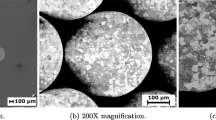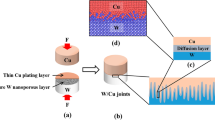Abstract
Ultrasonic welding (UW) process offers the ability to create highly efficient solid-state joints for lightweight metal alloys with low power consumption. During the process, a distinct diffusion layer is observed at the joint interface that undergoes severe plastic deformation at elevated temperature. A hierarchical multiscale method is proposed in this study to predict the diffusion behavior of the UW process of dissimilar materials. The method combines molecular dynamics and classical diffusion theory to calculate the thickness of the diffusion layer at the welded interface. A molecular dynamics model is developed for the first time that considers the effect of transverse ultrasonic vibration to simulate the evolution of the diffusion layer. The effect of ultrasonic vibration at the atomic level is assumed to provide thermal energy at the joint interface and the mechanical movement of atoms. The influence of sinusoidal velocity change during ultrasonic vibration is incorporated by numerically time integrating the diffusivity at different ultrasonic velocity. The simulation result shows that the solid-state diffusivity depends on temperature, pressure, and transverse ultrasonic velocity. Higher temperature, pressure, and ultrasonic velocity result in higher diffusivity leading to larger diffusion layer thickness. This article provides a comprehensive review of the diffusion bonding behavior and its dependence on process variables. It also presents a numerical approach combining molecular dynamics and hierarchical multiscale calculation to predict the diffusion layer thickness for the UW process of dissimilar materials.
Similar content being viewed by others
References
Kazuhiro N, Masao U (2002) Needs and prospects of dissimilar metal joining and welding. J Japan Weld Soc 71:418–421. https://doi.org/10.2207/qjjws1943.71.418
Martinsen K, Hu SJ, Carlson BE (2015) Joining of dissimilar materials. CIRP Ann - Manuf Technol 64:679–699. https://doi.org/10.1016/j.cirp.2015.05.006
Lee SS, Kim T-H, Hu SJ et al (2013) Characterization of joint quality in ultrasonic welding of battery tabs. ASME J Manuf Sci Eng 135:021004. https://doi.org/10.1115/1.4023364
Kicukov E, Gursel A (2015) Ultrasonic welding of dissimilar materials: a review. Period Eng Nat Sci 3:28–36. https://doi.org/10.21533/pen.v3i1.44
Li J, Han L, Zhong J (2008) Short-circuit diffusion of ultrasonic bonding interfaces in microelectronic packaging. Surf Interface Anal 40:953–957. https://doi.org/10.1002/sia.2840
Zhao YY, Li D, Zhang YS (2013) Effect of welding energy on interface zone of Al–Cu ultrasonic welded joint. Sci Technol Weld Join 18:354–360. https://doi.org/10.1179/1362171813Y.0000000114
Wu X, Liu T, Cai W (2015) Microstructure, welding mechanism, and failure of Al/Cu ultrasonic welds. SME J Manuf Process 20:321–331. https://doi.org/10.1016/j.jmapro.2015.06.002
Yang Y, Janaki Ram GD, Stucker BE (2009) Bond formation and fiber embedment during ultrasonic consolidation. J Mater Process Technol 209:4915–4924. https://doi.org/10.1016/j.jmatprotec.2009.01.014
Ginzburg S, Mitskevich A, Nosov Y (1967) Formation of the joint in ultrasonic welding. Weld Prod 13:45–47
Chang UI, Frisch J (1974) On optimization of some parameters in ultrasonic metal welding. Weld J 53:24–35
Lu Y, Song H, Taber GA, Foster DR, Daehn GS, Zhang W (2016) In-situ measurement of relative motion during ultrasonic spot welding of aluminum alloy using photonic Doppler velocimetry. J Mater Process Technol 231:431–440. https://doi.org/10.1016/j.jmatprotec.2016.01.006
Fujii HT, Goto Y, Sato YS, Kokawa H (2016) Microstructure and lap shear strength of the weld interface in ultrasonic welding of Al alloy to stainless steel. Scr Mater 116:135–138. https://doi.org/10.1016/j.scriptamat.2016.02.004
Zhang Z, Wang K, Li J, Yu Q, Cai W (2017) Investigation of interfacial layer for ultrasonic spot welded aluminum to copper joints. Sci Rep 7:12505. https://doi.org/10.1038/s41598-017-12164-2
Yang JW, Cao B, He XC, Luo HS (2014) Microstructure evolution and mechanical properties of Cu–Al joints by ultrasonic welding. Sci Technol Weld Join 19:500–504. https://doi.org/10.1179/1362171814Y.0000000218
Beyer W (1969) The bonding process in the ultrasonic welding of metals. Schweisstechnik 19:16–20
Watanabe T, Sakuyama H, Yanagisawa A (2009) Ultrasonic welding between mild steel sheet and Al–Mg alloy sheet. J Mater Process Technol 209:5475–5480. https://doi.org/10.1016/j.jmatprotec.2009.05.006
Watanabe A, Yanagisawa T, Konuma S et al (1999) The effect of oxide film on the strength of an ultrasonically welded joint and welding process - study of the ultrasonic welding of dissimilar metals (2nd report). Weld Int 13:936–944. https://doi.org/10.1080/09507119909452077
Xu L, Wang L, Chen Y-C, Robson JD, Prangnell PB (2016) Effect of interfacial reaction on the mechanical performance of steel to aluminum dissimilar ultrasonic spot welds. Metall Mater Trans A 47:334–346. https://doi.org/10.1007/s11661-015-3179-7
Ren D, Zhao K, Pan M, Chang Y, Gang S, Zhao D (2017) Ultrasonic spot welding of magnesium alloy to titanium alloy. Scr Mater 126:58–62. https://doi.org/10.1016/j.scriptamat.2016.08.003
Mielke SL, Troya D, Zhang S, Li JL, Xiao S, Car R, Ruoff RS, Schatz GC, Belytschko T (2004) The role of vacancy defects and holes in the fracture of carbon nanotubes. Chem Phys Lett 390:413–420. https://doi.org/10.1016/j.cplett.2004.04.054
Xiao S, Hou W (2006) Fracture of vacancy-defected carbon nanotubes and their embedded nanocomposites. Phys Rev B Condens Matter Mater Phys 73:1–7. https://doi.org/10.1103/PhysRevB.73.115406
Xiao S, Andersen DR, Han R, Hou W (2006) Studies of carbon nanotube-based oscillators using molecular dynamics. J Comput Theor Nanosci 3:142–147. https://doi.org/10.1166/jctn.2006.013
Xiao S, Hou W (2007) Studies of nanotube-based resonant oscillators through multiscale modeling and simulation. Phys Rev B Condens Matter Mater Phys 75:1–9. https://doi.org/10.1103/PhysRevB.75.125414
Ghaffari MA, Zhang Y, Xiao SP (2017) Molecular dynamics modeling and simulation of lubricant between sliding solids. J Micromechanics Mol Phys 2:1750009. https://doi.org/10.1142/S2424913017500096
Chen SY, Wu ZW, Liu KX, Li XJ, Luo N, Lu GX (2013) Atomic diffusion behavior in Cu-Al explosive welding process. J Appl Phys 113:044901. https://doi.org/10.1063/1.4775788
Konovalenko IS, Konovalenko IS, Psakhie SG (2017) Molecular dynamics modeling of bonding two materials by atomic scale friction stir welding. 020093:020092. https://doi.org/10.1063/1.5013773
Ye YY, Biswas R, Morris JR, Bastawros A, Chandra A (2003) Molecular dynamics simulation of nanoscale machining of copper. Nanotechnology 14:390–396. https://doi.org/10.1088/0957-4484/14/3/307
Li C, Li D, Tao X, Chen H, Ouyang Y (2014) Molecular dynamics simulation of diffusion bonding of Al–Cu interface. Model Simul Mater Sci Eng 22:065013. https://doi.org/10.1088/0965-0393/22/6/065013
Chen SD, Soh AK, Ke FJ (2005) Molecular dynamics modeling of diffusion bonding. Scr Mater 52:1135–1140. https://doi.org/10.1016/j.scriptamat.2005.02.004
Chen S, Ke F, Zhou M, Bai Y (2007) Atomistic investigation of the effects of temperature and surface roughness on diffusion bonding between Cu and Al. Acta Mater 55:3169–3175. https://doi.org/10.1016/j.actamat.2006.12.040
Zhang Q, Lai WS, Liu BX (1999) Molecular dynamics study of solid state interfacial reaction in the Ni-Mo system. J Comput Mater Des 6:103–116. https://doi.org/10.1023/A:100874620
Lee SS, Kim T-H, Hu SJ et al (2015) Analysis of weld formation in multilayer ultrasonic metal welding using high-speed images. ASME J Manuf Sci Eng 137:031016. https://doi.org/10.1115/1.4029787
Shen N (2018) Microstructure prediction of severe plastic deformation manufacturing processes for metals. University of Iowa
Shen N, Samanta A, Ding H, Cai WW (2016) Simulating microstructure evolution of battery tabs during ultrasonic welding. SME J Manuf Process 23:306–314. https://doi.org/10.1016/j.jmapro.2016.04.005
Zhao J, Li H, Choi H, Cai W, Abell JA, Li X (2013) Insertable thin film thermocouples for in situ transient temperature monitoring in ultrasonic metal welding of battery tabs. SME J Manuf Process 15:136–140. https://doi.org/10.1016/j.jmapro.2012.10.002
Plimpton S (1995) Fast parallel algorithms for short-range molecular dynamics. J Comput Phys 117:1–19. https://doi.org/10.1006/jcph.1995.1039
Cai J, Ye YY (1996) Simple analytical embedded-atom-potential model including a long-range force for fcc metals and their alloys. Phys Rev B 54:8398–8410. https://doi.org/10.1103/PhysRevB.54.8398
Nose S (1984) A unified formulation of the constant temperature molecular dynamics methods. J Chem Phys 81:511–519. https://doi.org/10.1063/1.447334
Hoover WG (1985) Canonical dynamics: equilibrium phase-space distributions. Phys Rev A 31:1695–1697. https://doi.org/10.1103/PhysRevA.31.1695
Parrinello M, Rahman A, R a PM (1980) Crystal structure and pair potentials: a molecular-dynamics study. Phys Rev Lett 45:1196–1199. https://doi.org/10.1103/PhysRevLett.45.1196
Mehrer H (2007) Diffusion in solids: fundamentals, methods, materials, diffusion-controlled processes. Springer, Berlin Heidelberg
Taneja D, Volpert M, Hodaj F (2018) On the initial stages of solid state reactions in Ni/Sn-Ag solder system at 150–210 °C. J Alloys Compd 742:199–211. https://doi.org/10.1016/j.jallcom.2018.01.253
Bai L, Xue W, Li Y, Liu X, Li Y, Sun J (2018) The interfacial behaviours of all-solid-state lithium ion batteries. Ceram Int 44:7319–7328. https://doi.org/10.1016/j.ceramint.2018.01.190
Hou W, Xiao S (2007) Mechanical behaviors of carbon nanotubes with randomly located vacancy defects. J Nanosci Nanotechnol 7:4478–4485. https://doi.org/10.1166/jnn.2007.862
Soyarslan C, Bargmann S, Pradas M, Weissmüller J (2018) 3D stochastic bicontinuous microstructures: generation, topology and elasticity. Acta Mater 149:326–340. https://doi.org/10.1016/j.actamat.2018.01.005
Li H, Choi H, Ma C, Zhao J, Jiang H, Cai W, Abell JA, Li X (2013) Transient temperature and heat flux measurement in ultrasonic joining of battery tabs using thin-film microsensors. ASME J Manuf Sci Eng 135:051015. https://doi.org/10.1115/1.4024816
Chen KK, Zhang YS (2015) Numerical analysis of temperature distribution during ultrasonic welding process for dissimilar automotive alloys. Sci Technol Weld Join 20:522–531. https://doi.org/10.1179/1362171815Y.0000000022
Funding
The authors would like to the financial support of the National Science Foundation under Grant Number CMMI-1537512.
Author information
Authors and Affiliations
Corresponding author
Additional information
Publisher’s note
Springer Nature remains neutral with regard to jurisdictional claims in published maps and institutional affiliations.
Rights and permissions
About this article
Cite this article
Samanta, A., Xiao, S., Shen, N. et al. Atomistic simulation of diffusion bonding of dissimilar materials undergoing ultrasonic welding. Int J Adv Manuf Technol 103, 879–890 (2019). https://doi.org/10.1007/s00170-019-03582-9
Received:
Accepted:
Published:
Issue Date:
DOI: https://doi.org/10.1007/s00170-019-03582-9




